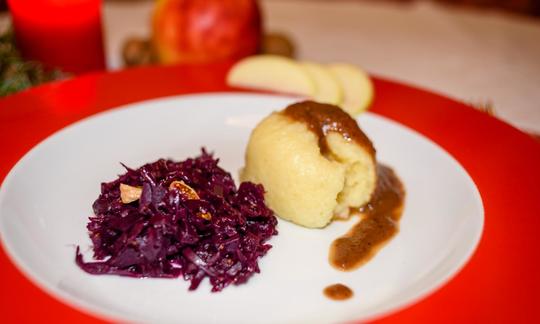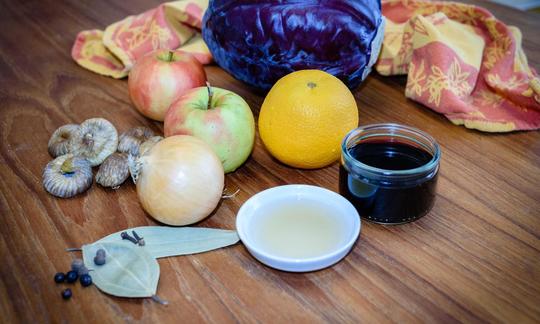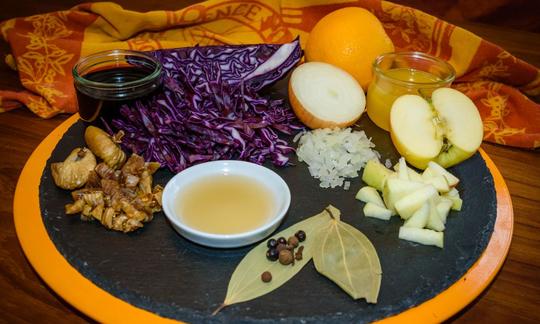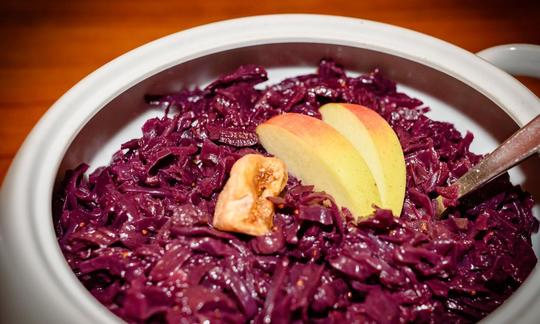apple red cabbage with figs
vegan
Ingredients (for servings, )
| For the basis | |
|---|---|
| 26 oz | Red cabbage, raw (organic?) |
| 2 tbsp | Apple cider vinegar (raw?, organic?) (1.0 oz) |
| 1 small | Onions, raw (organic?) (1.6 oz) |
| 2 | Apples, raw, with peel (11 oz) |
| 8 | Dried figs (raw?, organic?) (8.8 oz) |
| 1 tbsp | Rapeseed oil, refined (organic?) (0.49 oz) |
| For seasoning | |
| 200 ml | Table wine, red (raw?, organic?) (7.0 oz) |
| 3 tbsp | Balsamic vinegar, white (Condimento bianco, organic?, raw?) (1.7 oz) |
| 4 | Juniper berries (raw, organic?) (0.01 oz) |
| 4 | Allspice, seeds (raw?, organic?) (0.01 oz) |
| 2 leaves | Bay laurel (raw? organic?) (0.01 oz) |
| 2 | Cloves, whole (raw?, organic?) (0.01 oz) |
| 1 dash | Table salt (table salt, raw?, organic?) (0.01 oz) |
| 1 dash | Black pepper (organic?, raw?) (0.00 oz) |
| 1 | Oranges, raw (organic?) (4.6 oz) |
Equipment
- stove
- citrus juicer (lemon squeezer)
- saucepan
Type of preparation
- chop or grind
- braised
- squeeze
- sweat
- meld
- season to taste
- deglaze
- remove the skin
- knead
Preparation
Preparing red cabbage
Remove the outer 2 to 3 cabbage leaves. Then remove the stalk in a wedge shape with a long knife and quarter the cabbage with the knife to create more manageable pieces. You can then cut these into fine strips with a large knife.Then rinse the chopped cabbage thoroughly under cold water and let it drain. Add apple cider vinegar, mix it with the cabbage (it's best to knead it thoroughly) and let it sit for about 15 minutes. This makes the red cabbage more elastic.
Meanwhile, prepare the other ingredients (step 2).
Preparing red cabbage
Peel the onions and dice finely. Wash the apples and cut into small pieces. Cut the dried figs into small pieces as well.
Heat the oil in a large pan and sauté the onions. Add the spices and sauté for another minute, stirring. Deglaze with red wine and balsamic vinegar.Apple varieties: You can use various apple varieties for this dish, such as Golden Delicious, Granny Smith,Gala or Fuji.
Add the red cabbage to the onions in the pot and stir. Add water, apples and dried figs, stir again and let simmer with the lid closed for about an hour.
Finishing the Apple Red Cabbage with Figs
Squeeze the orange and mix the juice into the red cabbage. Season with salt and pepper and, if necessary, grape juice or a little agave syrup.Instead of red wine, you can also use grape juice. Depending on whether you use wine or grape juice and the sweetness of the orange juice, additional sweetening may or may not be necessary.
Once the "Apple Red Cabbage with Figs" is ready, let it simmer in a closed pot for another hour.
Before serving, it is best to remove the juniper berries, bay leaves, allspice and cloves.
|
Nutritional Information per person
Convert per 100g
|
2000 kcal | |
|---|---|---|
| Energy | 362 kcal | 18.1% |
| Fat/Lipids | 4.6 g | 6.6% |
| Saturated Fats | 0.43 g | 2.1% |
| Carbohydrates (inc.dietary fiber) | 73 g | 27.2% |
| Sugars | 51 g | 57.2% |
| Fiber | 13 g | 51.8% |
| Protein/Albumin | 5.4 g | 10.9% |
| Cooking Salt (Na:100.0 mg) | 254 mg | 10.6% |
| Essential micronutrients with the highest proportions | per person | 2000 kcal | |
|---|---|---|---|
| Vit | Vitamin C (ascorbic acid) | 129 mg | 162.0% |
| Vit | Vitamin K | 87 µg | 116.0% |
| Elem | Potassium, K | 1'107 mg | 55.0% |
| Min | Manganese, Mn | 0.96 mg | 48.0% |
| Vit | Vitamin B6 (pyridoxine) | 0.55 mg | 39.0% |
| Vit | Vitamin B7 (Biotin, ex vitamin H) | 16 µg | 32.0% |
| Vit | Vitamin B9, B11 (Folate, as the active form of folic acid) | 54 µg | 27.0% |
| Elem | Calcium, Ca | 212 mg | 26.0% |
| Min | Copper, Cu | 0.26 mg | 26.0% |
| Min | Iron, Fe | 3.2 mg | 23.0% |
Detailed Nutritional Information per Person for this Recipe
The majority of the nutritional information comes from the USDA (US Department of Agriculture). This means that the information for natural products is often incomplete or only given within broader categories, whereas in most cases products made from these have more complete information displayed.
If we take flaxseed, for example, the important essential amino acid ALA (omega-3) is only included in an overarching category whereas for flaxseed oil ALA is listed specifically. In time, we will be able to change this, but it will require a lot of work. An “i” appears behind ingredients that have been adjusted and an explanation appears when you hover over this symbol.
For Erb Muesli, the original calculations resulted in 48 % of the daily requirement of ALA — but with the correction, we see that the muesli actually covers >100 % of the necessary recommendation for the omega-3 fatty acid ALA. Our goal is to eventually be able to compare the nutritional value of our recipes with those that are used in conventional western lifestyles.
| Essential fatty acids | per person | 2000 kcal |
|---|---|---|
| Alpha-Linolenic acid; ALA; 18:3 omega-3 | 0.42 g | 21.0% |
| Linoleic acid; LA; 18:2 omega-6 | 0.97 g | 10.0% |
| Essential amino acids | per person | 2000 kcal |
|---|---|---|
| Tryptophan (Trp, W) | 0.04 g | 16.0% |
| Threonine (Thr, T, irreversibly transaminated) | 0.14 g | 15.0% |
| Valin (Val, V) | 0.19 g | 12.0% |
| Isoleucine (Ile, I) | 0.13 g | 11.0% |
| Lysine (Lys, K, irreversibly transaminated) | 0.18 g | 9.0% |
| Phenylalanine (Phe, F) | 0.13 g | 9.0% |
| Leucine (Leu, L) | 0.19 g | 8.0% |
| Methionine (Met, M) | 0.06 g | 6.0% |
| Vitamins | per person | 2000 kcal |
|---|---|---|
| Vitamin C (ascorbic acid) | 129 mg | 162.0% |
| Vitamin K | 87 µg | 116.0% |
| Vitamin B6 (pyridoxine) | 0.55 mg | 39.0% |
| Vitamin B7 (Biotin, ex vitamin H) | 16 µg | 32.0% |
| Vitamin B9, B11 (Folate, as the active form of folic acid) | 54 µg | 27.0% |
| Vitamin B1 (Thiamine) | 0.22 mg | 20.0% |
| Vitamin B2 (Riboflavin) | 0.23 mg | 17.0% |
| Vitamin A, as RAE | 121 µg | 15.0% |
| Vitamin E, as a-TEs | 1.8 mg | 15.0% |
| Vitamin B5 (Pantothenic acid) | 0.70 mg | 12.0% |
| Vitamin B3 (Niacin) | 1.5 mg | 9.0% |
| Essential macroelements (macronutrients) | per person | 2000 kcal |
|---|---|---|
| Potassium, K | 1'107 mg | 55.0% |
| Calcium, Ca | 212 mg | 26.0% |
| Magnesium, Mg | 87 mg | 23.0% |
| Phosphorus, P | 127 mg | 18.0% |
| Sodium, Na | 100 mg | 12.0% |
| Essential trace elements (micronutrients) | per person | 2000 kcal |
|---|---|---|
| Manganese, Mn | 0.96 mg | 48.0% |
| Copper, Cu | 0.26 mg | 26.0% |
| Iron, Fe | 3.2 mg | 23.0% |
| Zinc, Zn | 0.91 mg | 9.0% |
| Selenium, Se | 1.8 µg | 3.0% |
| Fluorine, F | 55 µg | 2.0% |
| Iod, I (Jod, J) | 3.6 µg | 2.0% |
Apple red cabbage with figs is a classic in winter cuisine. It is easy to prepare and healthy.
Nutrient profile: One portion of this recipe covers significantly more than the average daily requirement of vitamin C and vitamin K. The essential macronutrients potassium and manganese are covered by about 50%. The ratio of omega-6 to omega-3 fatty acids is 3:1, below the maximum recommended ratio of 5:1. More on this under: Vegans often eat unhealthily. Avoidable nutritional errors.
However, heating during preparation results in a loss of ingredients. Since the nutrient profile primarily refers to uncooked ingredients, the values are actually somewhat lower.
Red cabbage: Red cabbage, also known as blue cabbage, blue cabbage and red cabbage. It is a particularly aromatic relative of white cabbage. It differs from white cabbage mainly in its red color and sweet taste. Its head is somewhat smaller and firmer. It is a typical winter vegetable, but is almost always available fresh and can be stored well. Red cabbage is rich in ascorbic acid (vitamin C), iron, minerals and anthocyanins.
Juniper berries: Juniper is the only example of a spice from the group of conifers. Juniper berries taste aromatic and slightly spicy. Juniper goes well with pepper, marjoram and bay leaves and fruits.
Bay leaves: The shiny, aromatic leaves of the bay laurel can be used fresh or dried. They have a unique piquant, spicy aroma.
Allspice: Jamaica is the main growing area for allspice plants. Allspice is particularly popular in Caribbean cuisine. Its rich flavor is reminiscent of pepper, cinnamon, nutmeg and cloves. This is why allspice is also known as four-spice or all-spice.
Carnations: The Cloves, also known as spice cloves, are the dried flower buds of the clove tree, which are commercially available as small brown buds. They are strongly scented and have an intense, sharp taste, which is why they are used in small doses in the kitchen as a seasoning. The essential oils they contain determine their smell and taste, the main component of which is eugenol, which is also found in (Ceylon) cinnamon.
Red cabbage: The red pigment in red cabbage, anthocyanin, stains easily.
Serving: In many families, recipes with braised red cabbage are an integral part of the Christmas menu. It is a classic side dish for goose or game. However, it also goes excellently with a vegan nut or lentil roast or patties. The apple red cabbage is also an ideal side dish for potatoes or dumplings with sauce. The red cabbage is also suitable as a side dish for the following recipes: Barbara's Christmas roast with red wine and plum sauce, baked savoy cabbage rolls in caramel sauce. Other suitable sauces are the winter vegan gravy and the simple vegan gravy.
Oils: Cold-pressed rapeseed oil is not suitable in this case, as cold-pressed oils can only be heated slightly, in the case of cold-pressed rapeseed oil up to a maximum of 120 °C, as otherwise harmful substances are created. See the following link ( cold-pressed rapeseed oil). But refined rapeseed oil should also be heated up to a maximum of 180 °C. Under no circumstances should it start to smoke, although decomposition will begin before that.
Dried fruits are often sulphurized: The sulphur coating helps prevent rotting as it inhibits the metabolism of many microorganisms and thus improves the shelf life of the product, while also preserving the colour of the fruit. However, the preservation process destroys some vitamins, such as folic acid, and sulphur can have health consequences for asthmatics and allergy sufferers. It is therefore best to use unsulphured fruit.
Grape juice: You can also use grape juice instead of red wine.
Apple varieties: You can use various apple varieties for this dish, such as Golden Delicious, Granny Smith,Gala or Fuji.










